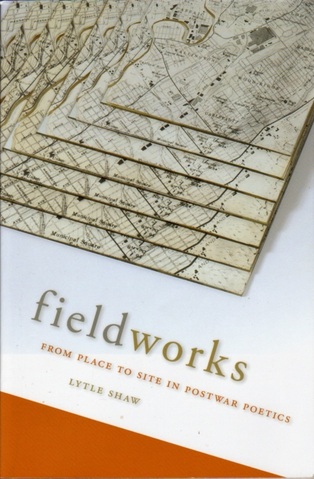
Lytle Shaw's Fieldworks is both fascinating and perplexing. All literary history and criticism operates by synecdoche, taking selected lines and passages and assembling them to represent an overall work or period. In nine chapters Shaw examines work by eight writers or groups of writers to document the changing ways in which US poets have conceived locality, from William Carlos Williams’s Paterson, Charles Olson’s Gloucester, Jerome Rothenberg’s ethnopoetics, Amiri Baraka’s Newark, through the Bolinas poets community of the late 1960s to Clark Coolidge and Bernadette Mayer’s conceiving of the book as a site, and the Flarfists and other late conceptualists conceiving discourse itself to be a multiplicity of sites. In a sense these chapters are like eight core samples drilled into a vast geography – they tell you something of what is there but not a whole lot of what is there. The chapters are juxtaposed but not necessarily connected. There is a rough chronology from Williams to Flarf but many concurrent moments of contrast and disconnection -- which is good, because major developments in poetics can be concurrent and not necessarily connected. The chapters fulfill the promise of the title of demonstrating the poetics of place and site in some US postwar poetry. But do they support the generalizations which he offers about such matters as “the New American poets and their immediate successors” or “the present moment in poetics” (261) when the work of so many of the major US postwar poets – Zukofsky, Duncan, Levertov, Spicer, O’Hara, Ashbery, Mac Low among them – is unconsidered? Perhaps it’s best to read the generalizations only as plausible hypotheses.
There is of course another generalization implicit in this book – that only poets who are usually considered experimental, avant-garde, cutting-edge or ‘research’ poets constitute the US’s contemporary or “postwar”
Shaw refers frequently to his poets as “New American” (in an explicit reference to Donald Allen’s 1960 anthology), “Language” and “post-Language” – but most of the poets associated with those namings are not discussed here. His focus is on poetries that address or are situated within specific locations, whether on the basis of an assumed genius loci, environmental determinants, social histories, potential for social creation, or the assumption of discourse itself as a social site. Readers who can remember the North American little mag culture of the 50s, 60s and 70s will encounter numerous once-resonant names – Jerome Rothenberg, Vincent Ferrini, Amiri Baraka, Ron Pagett, Diane di Prima, Clark Coolidge, Joanne Kyger, Ebbe Borregaard, Bernadette Mayer, Philip Whalen, Brother Antoninus, Ed Sanders, Lew Warsh, David Meltzer.
Shaw’s chapters vary greatly – possibly because of the fifteen years which he says it took him to write Fieldworks. The relatively brief (22 pages) Olson chapter is filled with potentially productive insights into O’s poetry, and could probably have been a book. The somewhat longer (27 pages) Baraka chapter is mainly social, political and personal history and appears to exhaust what Shaw has to say -- i.e. he doesn’t appear to have much interest in Baraka’s writing. Something similar happens in his Bolinas chapter on the poetics of small-scale communal relation; here it’s mainly with Creeley’s poems that he finds this poetics operative in actual writing; with the poems of the other poets, not so much. Overall, his most valuable contribution in the book may be his revision and expansion of what artists can consider “place” and “site” to be.
FD
 RSS Feed
RSS Feed